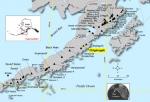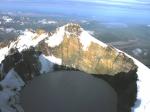Chiginagak volcano's acid crater-lake continues to supply acidic, metal-laden water to salmon spawning habitat on the Alaska Peninsula
 Figure 1
Figure 1For four years, the annual run of salmon up the King Salmon River and into Mother Goose Lake, has been halted by persistent acidic conditions caused by the continual release of acid, metal-laden water from Chiginagak volcano's crater lake (figure 1). In May of 2005, approximately 3.8 million cubic meters of acid water was released from a newly-formed lake in the summit crater of the volcano. The discharge represented only a partial draining of the crater-lake and observations this summer indicate that over 1 million cubic meters of water remains in the crater and continues to supply acid water to Mother Goose Lake and the King Salmon River (figure 2). Recent pH measurements indicate a slight improvement in
 Figure 2
Figure 2habitat conditions; however the water is far from hospitable. After the initial release in 2005, the pH of Mother Goose Lake dropped to a pH of 2.9 (7 is normal, the pH of grapefruit juice is about 3). This summer (August 2008) the pH of Mother Goose Lake was 4.5 (between tomato juice and black coffee). Anomalous high concentrations of iron (~25 mg/L) and aluminum (~18 mg/L) appear to be the most serious environmental threat in terms of metals. Hazardous metals such as arsenic, chromium, and copper are elevated well above normal levels. In 2005, copper concentrations exceeded the U.S. Environmental Protection Agency's chronic exposure limit for aquatic life at most sampled sites and several sites exceeded the acute exposure limit. Based on the large volume of acidic water remaining in the crater lake, the likely continued contribution of acid water from the volcano's hydrothermal system, and the prolonged hydrolysis of iron and aluminum in the stream draining the crater and in Mother Goose Lake, improved water quality is not expected for at least several more years.